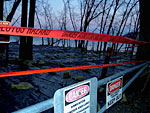By Mary Losure
Minnesota Public Radio
December 14, 2001
|
| RealAudio |
The little town of Lakeland on the St. Croix River has a big problem. Someone apparently dumped several garbage bags worth of a rare and deadly type of asbestos on the city's beach. Civil and criminal investigations are underway.
| |
|
|
|
||
The municipal beach for the city of Lakeland - population 1,917 - is tucked under the trees along the steep banks of the Saint Croix River, just north of the Interstate 94 bridge to Wisconsin. A narrow, winding road dead-ends at the secluded spot.
These days, it bristles with Keep Out signs.
State emergency workers have sealed off the beach with red plastic tape printed with asbestos warnings and covered the ground with heavy, black plastic weighted by sandbags.
Asbestos causes cancer when its fibers become airborne and are breathed into the lungs. There's no danger now because the area has been wetted down and sealed. Some 800 pounds of contaminated sand have been removed.
Lakeland Mayor E. Craig Morris still worries about the asbestos that may remain. He says there's no worse place for it than a public beach.
"You have maybe children that are digging in the sand or animals that are close to the ground. That's where you're going to have the opportunity for this material to become disturbed. And you're going to have people who, perhaps, are laying out sunbathing who are going to be very near the surface area, and thus their exposure potential is going to be extremely high," Morris said.
Last season the beach was closed due to flooding and flood damage, so the general public has not been exposed to the asbestos, which was discovered this fall.
At first, people in Lakeland thought the asbestos had washed up from the river, but the Minnesota Pollution Control Agency's Jeff Connell says further investigation found no asbestos anywhere else along the shoreline.
"This beach doesn't stand out as a point on the river. This beach is fairly insignificant in its size. There would be no reason for this beach to have received some sort of concentration of asbestos washing up on shore that no other beach along the Saint Croix would have received on either side of the river. This material was dumped there," Connell says.
It looked like dirty, soggy Kleenex, but microscopic examination showed it was what's known as amosite. Amosite is one of the rarest and most dangerous types of asbetos. Its fibers are hooked, and can lodge in the lungs for many years.
They cause the rare cancer that killed long-time Minnesota Congressman Bruce Vento.
Before its dangers were known, amosite was an industrial grade insulation used in power plants, incinerators, and other situations involving high heat and pressure. But years of MPCA inspections of state industries have found no evidence that the rare asbestos was used in Minnesota.
The investigators of the Lakeland beach dumping did find it in one place nearby: a house adjacent to the beach. Connell says investigators believe the contractor who built the house in the 1950s may have insulated it with amosite left over from an industrial construction site where he worked at about the same time. That site, the Garrison dam in North Dakota, was insulated with amosite.
In the late '90's, the house's current owner remodeled and removed much of the amosite, but Connell says MPCA investigators found residues of it still in the house.
| |
|
|
|
||
"This told us that the asbestos that came on the beach is the same as what was used in that house, and as far as we can tell, nowhere else in Minnesota," he says.
Connell says investigators believe that asbestos from the house was dumped on the beach within the last year. He says whoever is responsible could be liable for the cost of the cleanup, plus substantial civil penalties.
So far, the city of Lakeland has spent as much as $15,000 and the state of Minnesota more than $12,000.
This spring, the beach will have be excavated in layers until clean sand is reached. That could cost as much as $100,000. The responsible party could also face criminal penalties.
Washington County Sheriff Jim Frank says a case may be difficult to prove beyond a reasonable doubt. "There are no fingerprints on asbestos," he said.


